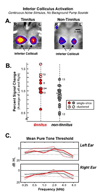The auditory midbrain of people with tinnitus: abnormal sound-evoked activity revisited
- PMID: 19699287
- PMCID: PMC2760154
- DOI: 10.1016/j.heares.2009.08.005
The auditory midbrain of people with tinnitus: abnormal sound-evoked activity revisited
Abstract
Sound-evoked fMRI activation of the inferior colliculi (IC) was compared between tinnitus and non-tinnitus subjects matched in threshold (normal), age, depression, and anxiety. Subjects were stimulated with broadband sound in an "on/off" fMRI paradigm with and without on-going sound from the scanner coolant pump. (1) With pump sounds off, the tinnitus group showed greater stimulus-evoked activation of the IC than the non-tinnitus group, suggesting abnormal gain within the auditory pathway of tinnitus subjects. (2) Having pump sounds on reduced activation in the tinnitus, but not the non-tinnitus group. This result suggests response saturation in tinnitus subjects, possibly occurring because abnormal gain increased response amplitude to an upper limit. (3) In contrast to Melcher et al. (2000), the ratio of activation between right and left IC did not differ significantly between tinnitus and non-tinnitus subjects or in a manner dependent on tinnitus laterality. However, new data from subjects imaged previously by Melcher et al. suggest a possible tinnitus subgroup with abnormally asymmetric function of the IC. The present and previous data together suggest elevated responses to sound in the IC are common among those with tinnitus and normal thresholds, while abnormally asymmetric activation is not, even among those with lateralized tinnitus.
Figures





References
-
- Adjamian P, Sereda M, Hall DA. The mechanisms of tinnitus: perspectives from human functional neuroimaging. Hearing Res. Epub. 2009 - PubMed
-
- Arnold W, Barenstein P, Oestreicher E, Romer W, Schwaiger M. Focal metabolic activation in the predominant left auditory cortex in patients suffering from tinnitus: a PET study with [18F]deoxyglucose. ORL. 1996;58:195–199. - PubMed
-
- Beck AT, Epstein N, Brown G, Steer RA. An inventory for measuring clinical anxiety: Psychometric properties. J. Consult. Clin. Psychol. 1988;56:893–897. - PubMed
-
- Beck AT, Ward CH, Mendelson M, Mock J, Erbaugh An inventory for measuring depression. J. Arch. Gen. Psychiatry. 1961;4:561–571. - PubMed
-
- Brittain FH. The loudness of continuous spectrum noise and its application to loudness measurements. J Acoust Soc Am. 1939;11:113–117.
Publication types
MeSH terms
Grants and funding
LinkOut - more resources
Full Text Sources
Other Literature Sources
Medical

